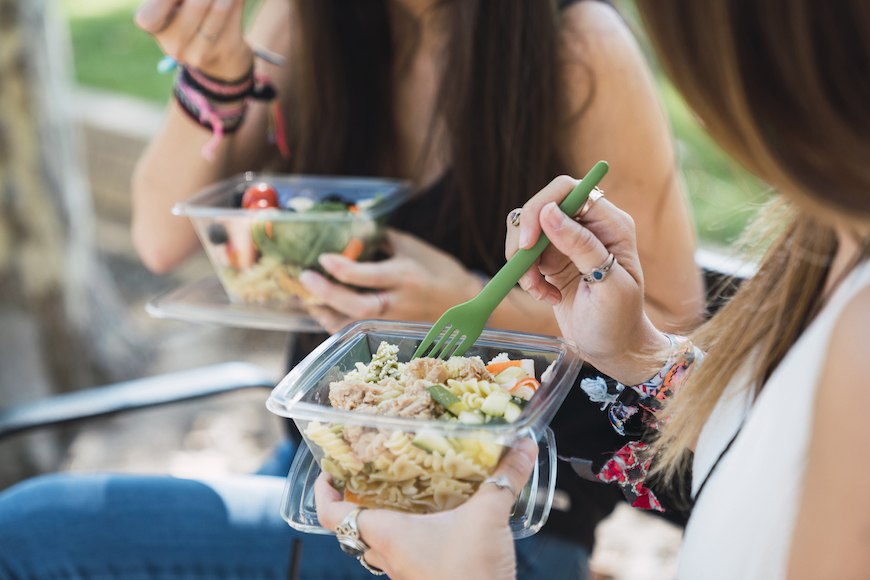
September 11, 2019 at 03:00PM by CWC
It’s hard to believe that when plastic was first invented in the early 1900s, it was seen as a technological miracle. Now, plastic is so deeply ingrained into our daily lives that it’s impossible to avoid (just ask one editor who attempted #PlasticFreeJuly). It’s in our clothing, beauty products, phones, furniture, toys, and now, our bodies.
According to a recent study, humans are unintentionally breathing and ingesting tiny particles of plastic, aka microplastics. These microplastics, which are each roughly the size of a sesame seed, can come from larger plastics that have broken up or from microbeads of plastic that are deliberately added to beauty products (like cleansers). The study found those tiny plastic particles showing up in stool samples from people living all over the world.
Having plastic pieces floating around in our bodies does not sound particularly ideal. But what does the ubiquitousness of microplastics truly mean for our health? Here, some of the top toxicologists who have studied microplastics share what we know—and what we don’t know.
How microplastics end up in our bodies
It’s understandably unnerving to think about how there’s very likely tiny pieces of plastic in your body right now. But it’s also important to know that microplastics are small—like, really small. According to the National Institute of Health, they’re less than five millimeters big. (That’s half a centimeter.) “They are in consumer products such as synthetic clothing fabric, toothpaste, and skincare products,” the NIH’s site reads. “They are also formed when plastics break apart into tiny beads.”
ADVERTISEMENT
ADVERTISEMENTKate Spade Autumn/Winter Sale |
Per the NIH, microplastics are so small that when they wash down a drain, they aren’t filtered at all by wastewater treatment—meaning they go directly into the oceans. Since plastic takes so long to break down (up to 1000 years), they then just stay in our ocean systems to be consumed by animals and otherwise impact the ecosystem.
Because so much plastic ends up in the ocean—an estimated eight million tons per year, according to the National Ocean Services—toxicologists have taken a particular interest in studying microplastics in fish and sea animals. They’re definitely being ingested by ocean life; they’ve been found in crabs’ brains as well as in the bodies of a sample of 50 marine mammals. In one study, scientists saw a correlation between microplastics and brain damage in fish. “In a broader perspective, our findings demonstrate that plastic nanoparticles are transferred up through a food chain, enter the brain of the top consumer and affect its behavior, thereby severely disrupting the function of natural ecosystems,” the study reads.
It’s not just an ocean issue. Heather Leslie, PhD, an ecotoxicologist specializing in microplastics at the Vrije University in Amsterdam, found that microplastics are also showing up in animal stool samples. “It’s difficult for people to avoid microplastics day to day because there are millions of sources of fine plastic particulates in the living environment and food chain,” Dr. Leslie says, such as in groundwater or even in the air around us.
Kieran Cox, a PhD candidate and Hakai Scholar at the University of Victoria, has spent years studying human consumption of microplastics and is the lead researcher on a study that was recently published in the journal Environmental Science & Technology. “The goal of our study was to determine the average concentration of microplastics in [substances] including air, water, and food,” he explains. “We looked at all the ways microplastics could end up in the human body.” The number one culprit his team found: bottled water.
Do microplastics affect human health?
Yes, microplastics are everywhere; there’s virtually no avoiding them. (Remember how I said they’re literally in the air?) Yet all the experts interviewed for this article emphasized that there hasn’t been any official confirmation that they are harmful for human health.
That isn’t to say that experts aren’t concerned. Recently, the World Health Organization released a statement saying that more research needs to be done on microplastics to determine their potential impact on human health. That’s a sentiment shared by biochemist Andrew Mayes, PhD, who developed the technology used to detect microplastics in bottled and tap water around the world; WHO referred to his data in their report. “We really need the technology to perform more studies that can show us the effects,” he says. “Many studies have been done on marine animals, but no studies—that I know of—have been done on how microplastics affect human health because it would be unethical to give humans plastics to ingest for a study,” he says.
“Plastic is not classified as food for humans or animals and there might even be a general consensus that it doesn’t belong in the food chain at all,” adds Dr. Leslie. “The responsible thing to do is not to panic, but to investigate the early warnings in a thorough, critical and transparent manner, communicate them, and take precautionary measures to protect human health and environment.”
The thought of drinking, eating, and breathing tiny pieces of plastic is certainly unnerving. But Dr. Mayes emphasizes that it’s too early to be worried about microplastics’ impact on human health. “When you put the issue of microplastics on a global scale, it’s not a top concern. People in many countries don’t have access to safe drinking water. If you live in Bangladesh, for example, a few microplastics in your water is the least of your concerns.” Or in Flint, Michigan, where there is still debate five years later over whether the water is free from lead contamination.
“It’s difficult for people to avoid microplastics day to day because there are millions of sources of fine plastic particulates in the living environment and food chain,” says Dr. Leslie. “This is why I think the sources need to be targeted, because once they are let loose it’s impossible to round them all up again. Prevention saves trouble and expense and it’s the most effective way to keep plastic off your menu.”
Where to start? “If you don’t drink water out of a plastic bottle, that will decrease your exposure to microplastics by 22 times,” Cox suggests, referring to one of the findings of his study. Other ways he says you can reduce your exposure: not using plastic forks or spoons, storage containers, cooking utensils, or plastic wrap.
When it comes to microplastics and human health, we just don’t know what the deal is. What we do know is that plastic is bad for the earth. So even if it’s not for your health, limiting your plastic use still has major, global benefits.
Here are some easy ways to reduce your plastic use. Plus, what happened when one Well+Good writer tried to live plastic-free for one month.
ADVERTISEMENT
ADVERTISEMENTSports Direct Free Delivery on All Orders! |
Author Emily Laurence | Well and Good
Selected by CWC
ADVERTISEMENT
ADVERTISEMENTUp to 30% off Gift Sets |







